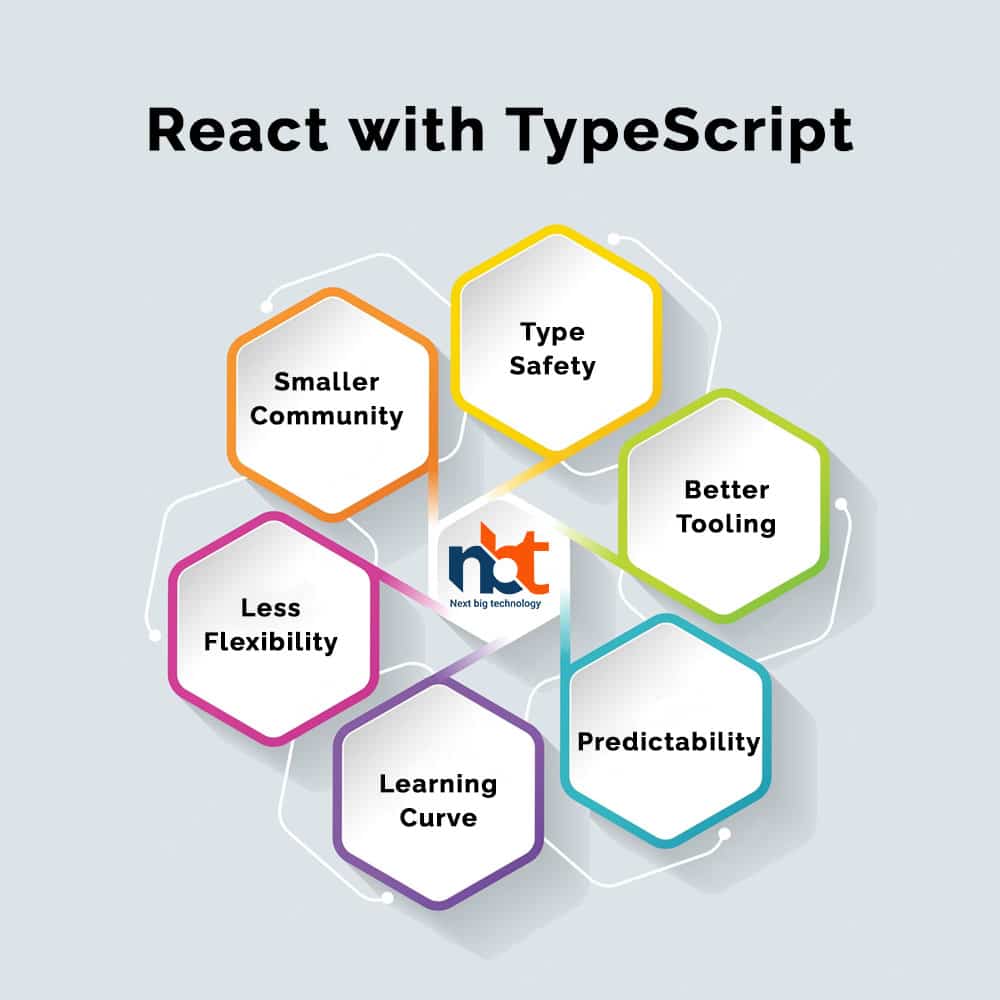React has been the most prevalent front-end JavaScript library for a long time. Its component-based architecture, declarative programming style, and ease of utilization have made it the go-to choice for developers building cutting-edge web applications. With the later rise in popularity of TypeScript, numerous designers are pondering whether they should utilize TypeScript or JavaScript when working with ReactJS.
In this article, we will explore the advantages and drawbacks of utilizing React with TypeScript and JavaScript to assist you in making an informed choice.
Table of Contents
What Is TypeScript?
TypeScript may be a strongly-typed, open-source programming language created by Microsoft. It may be a superset of JavaScript, which implies that it builds on the best of JavaScript and includes modern features and usefulness to the language.
One of the most essential features of TypeScript is its support for static typing. In JavaScript, factors can be of any data type, and the type of a variable is decided powerfully at runtime. This will sometimes lead to issues when working with large codebases because it can be challenging to guarantee that factors are utilized accurately throughout the code.
In TypeScript, variables can be expressly written, which implies that the data type is determined at compile-time instead of runtime. This will make capturing errors before the code is run less demanding and can offer assistance with code documentation and meaningfulness.
Another essential incorporation of TypeScript is its support for classes and interfacing. In JavaScript, object-oriented programming can be satisfied by utilizing constructor capacities and models, but this will need to be balanced and easier to inspect. TypeScript gives built-in back for classes and meddling, which can make object-oriented programming more common and expected.
TypeScript also includes other features, tallying support for modules, generics, and decorators. It can be compiled into JavaScript, which recommends that it can run in any browser that supports JavaScript.
In general, TypeScript can be an effective instrument for building large-scale, complex applications, as its bolster for inactive writing and object-oriented programming can make it simpler to type in viable, versatile code.
Also Read : Guide to TypeScript vs. JavaScript: Which Language to Use?
What Is JavaScript?
JavaScript could be a high-level, energetic, and translated programming language used to make interactive web pages and applications. It was, to begin with, discharged in 1995 by Netscape and has since ended up being one of the foremost prevalent programming languages in the world.
JavaScript is fundamentally utilized for client-side scripting, which implies that it runs in the client’s web browser instead of on the server. This permits developers to make energetic, intuitive web pages that react to client input and upgrade in real-time.
One of the key features of JavaScript is its capacity to manipulate the Document Object Model (DOM), which represents the HTML and CSS on a web page. JavaScript can be utilized to modify the content of a web page, include or expel elements, and react to user events such as mouse clicks and console inputs.
JavaScript is a flexible language that can be utilized for server-side programming, much obliged to the presentation of server-side JavaScript stages such as Node.js. This permits programmers to type in both the client-side and server-side code for a web application utilizing the same language, simplifying the development process and diminishing the likelihood of errors.
Generally, JavaScript is a capable and adaptable programming language broadly used to make interactive web pages and applications. Its popularity and flexibility have made it a basic aptitude for web developers, and it is likely to stay a key innovation for the predictable future.
Also Read : Difference Between Typescript & JavaScript That You Need to Know
React with JavaScript
JavaScript is the language that Reactjs was built with and continues to be the most prevalent language for front-end development. On the off chance that you select to use React with JavaScript, you’ll enjoy the taking after benefits:

1. Easy to learn:
JavaScript is one of the world’s foremost widely used programming languages, and most developers are already familiar with its syntax and structure. If you’re comfortable with JavaScript, learning React will be relatively simple.
2. Large Community:
JavaScript has a massive community with a wealth of assets and devices accessible. If you experience issues while working with React, you can easily find answers online or in community gatherings.
3. Flexibility:
JavaScript could be a profoundly flexible language, and you can use it in various contexts, including server-side improvement, mobile app development, and more.
There are, moreover, a few downsides to using React with javascript.
4. Need of Type Safety:
JavaScript is dynamically written, which implies that type errors can happen at runtime. This may lead to difficult-to-debug issues, particularly in more significant projects.
5. Trouble in Scaling:
JavaScript can be challenging to scale, mainly when working on larger projects. With sort security, ensuring the codebase remains reliable and viable can be more accessible.
6. Less Predictable:
Moreover, JavaScript’s need for type security implies that it can be less predictable than TypeScript. Ensuring that all of the code is carried on as expected can be challenging when working with large codebases.
Also Read : Why you should Learn ReactJS in 2023
React with TypeScript
TypeScript could be a superset of JavaScript that adds inactive writing and other features to the language. By using TypeScript with React, you’ll enjoy the following benefits:

1. Type Safety:
TypeScript includes static typing to JavaScript, which suggests that you can capture mistakes sometime during runtime. This will simplify investigating issues and guarantee that your codebase is viable and adaptable.
2. Better Tooling:
TypeScript contains a range of practical instruments available, including code editors and linters, that can help you write better code faster.
3. Predictability:
TypeScript’s type security also means that your code can be more predictable. This can be particularly valuable in larger codebases, where keeping track of all the diverse moving parts can be challenging.
Be that as it may, there are too some downsides to using React with TypeScript:
4. Learning Curve:
If you still need to become familiar with TypeScript, a learning curve can be included in getting begun with it. This may include an additional layer of complexity to the development process.
5. Less Flexibility:
TypeScript is less adaptable than JavaScript because it is designed specifically for use with TypeScript. This implies that there may be better choices for projects that require a more flexible language.
6. Smaller Community:
While TypeScript has a growing community, it is still smaller than JavaScript. This means that there may be fewer resources and devices accessible.
Also Read : How to build fast and SEO-friendly web apps using ReactJs, Redux, and NextJs
To Make a React Project in Typescript:
To create a new Respond project using TypeScript, you can use the Make React App tool, a popular command-line interface for rapidly and effortlessly setting up React projects.
Here are the steps to create a new React project in TypeScript using Create React App:
Open your terminal and explore the directory where you must do your project.
- Introduce Create React App all-inclusive, on the off chance that you haven’t as of now done so:
npm install -g create-react-app
- Create a new React project utilizing TypeScript by running the taking after the command:
npx create-react-app my-app –template typescript
This will return a new React project named “my-app” with TypeScript.
- Once the project has been done, explore the project directory by running the taking after the command:
cd my-app
- Start the development server by running the following command:
npm start
This will start the development server and open your React application in the browser.
That’s it! You presently have a new React project set up with TypeScript. You can build your application by editing the files in the “src” directory. You can also add new dependencies by altering the “package.json” file and introducing them utilizing the “npm install” command.
Note that Create React App will handle the configuration of TypeScript and other devices, so you can focus on building your application.
Also Read : Nodejs vs. Reactjs Comparison: Which to Choose For Your JS Project?
Reasons for Utilizing TypeScript with React:
There are several compelling reasons why developers might select to use TypeScript with React. Here are some of the fundamental advantages:
1. Static Typing:
One of the most benefits of TypeScript is its support for static typing. By expressly declaring the data types of variables, functions, and interfacing, TypeScript can offer assistance to catch errors and give superior code documentation and readability. This can be particularly valuable when working on large-scale projects with multiple developers, as it guarantees everyone is on the same page and takes after best practices.
2. Improved Code Quality:
The use of static typing can also improve the significant quality of the code by reducing the probability of runtime errors. This can assist in catching potential bugs earlier in the development process, making it easier to fix them before they become more significant issues. Additionally, TypeScript gives a run of features such as type checking and code analysis that can assist developers in identifying potential problems before they happen.
3. Easier Refactoring:
TypeScript can make it less demanding to refactor code by giving more data about the structure of the code. By using interfaces and other TypeScript-specific features, developers can more effortlessly identify which parts of the code will be affected by a change, making it less demanding to make modifications without presenting new bugs.
4. Better IDE Support:
Many modern IDEs and code editors greatly support TypeScript, counting features like auto-completion, code navigation, and code analysis. This can make it easier and quicker to type in code, as developers can get real-time criticism on potential issues and recommendations for improving their code.
5. Larger Community:
As React has become more popular, so has TypeScript with React. This has driven a developing community of developers using TypeScript to build React applications, which in turn has conducted a range of resources and tools that can be utilized to simplify development and make it easier to find and offer assistance when needed.
Overall, while it is possible to build React applications utilizing JavaScript alone, several points of interest to using TypeScript can make it a more attractive option for numerous developers. The utilization of static typing, improved code quality, more straightforward refactoring, better IDE support, and a larger community are all factors that can make TypeScript a powerful tool for building robust and versatile React applications.
Also Read : The benefits of ReactJS and reasons to choose it for your project
Choosing Between TypeScript and JavaScript for React:
So, which should you choose:
TypeScript or JavaScript? Eventually, the decision will depend on your specific project and development team. Be that as it may, here are a few standard rules to help you make an informed choice:
1. Project Size:
For littler projects, JavaScript may be the best choice. However, TypeScript’s type safety and consistency for more extensive projects can make it easier to preserve and scale.
2. Development Team:
If your development team is already familiar with TypeScript, it may be a good choice for your project. However, if your group is more comfortable with JavaScript, it may be better to stick with what they know.
3. Timeframe:
If you’re working on an extension with a tight deadline, using JavaScript may be the quicker option, as it includes a shorter learning curve. In any case, if you have more time and need to guarantee that your codebase is viable in the long term, TypeScript may be the better choice.
4. Required Features:
If your project requires specific features that are as were accessible in TypeScript, such as interfacing and decorators, at that point, TypeScript may be the as-it-were choice.
5. Tooling:
If you’re working with a toolchain that includes tools like linters and code editors, TypeScript may be a far better choice. These tools can help you compose better code faster and be especially useful in bigger codebases.
Also Read : Key Reasons to Hire ReactJS Developers for Customer-Centric Business
Conclusion
React can be utilized with either TypeScript or JavaScript; each option has advantages and disadvantages. Ultimately, the choice will depend on your particular project and development group. If you’re working on a larger project requiring type safety and predictability, TypeScript may be the better choice. On the other hand, if you’re working on a little project or need more flexibility, JavaScript may be the better option.
In any case, TypeScript and JavaScript are powerful tools that can assist you in building modern, scalable web applications.
Thanks for reading our post “React with TypeScript or JavaScript: Which is Better?”. Please connect with us to know more about ReactJS Development and Javascript Development.


















